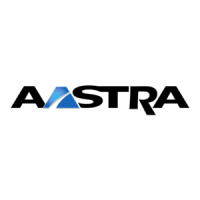Call routing
244
System functions and features as of R3.0
syd-0367/1.3 – R3.0 – 03.2013
Note:
If an exchange-to-exchange connection is transferred to the exchange
using Partial Rerouting or Call Deflection, the communication server no
longer has any control over the connection and therefore cannot discon-
nect it.
Analogue-Analogue (A-A) or Digital-Analogue (D-A)
Release on the analogue interface cannot be guaranteed with these connection
types. On analogue network interfaces the communication server detects loop in-
terruptions, polarity reversal and congestion tone as release criterion. The detec-
tion can be configured for each analogue network interface (CM 2_2_1).
Tab. 76 Release signal: System configuration
Aastra Intelligent Net:
Detection of the congestion tone is automatically adapted to the country
configured under the region. In an AIN the nodes may be spread over dif-
ferent regions or even countries. A region is assigned to one or more AIN
nodes. An region can also be assigned for each trunk group. The trunk
group allocation takes priority over the node-specific allocation.
• Any exchange-to-exchange connection is disconnected at the latest after 2
hours.
• The maximum duration of an analogue exchange-to-exchange connection can
be further restricted for the A-A connection type (1...120 minutes).
Note:
As release cannot be guaranteed for connection types D-A and A-A, unin-
tentional high costs can occur. What's more the national guidelines and
regulations should be observed before enabling these connection types.
Parameter Parameter value Remarks
Release signal <Ye s / No>
Release signal type <Loop-break / Polarity reversal /
Congestion tone >
The frequency and the time sequence of
the congestion tone vary from country to
country.
Congestion tone level <Low / High> The sound level of the congestion tone can
vary greatly within a country and depend-
ing on the line length. With this setting the
detection can be adapted to the existing
level.

